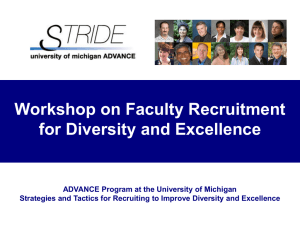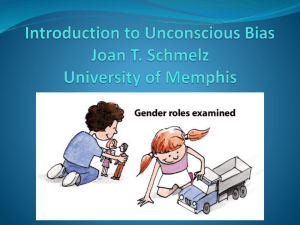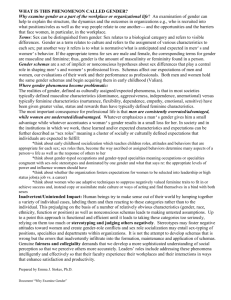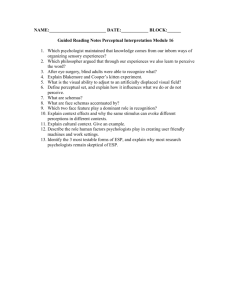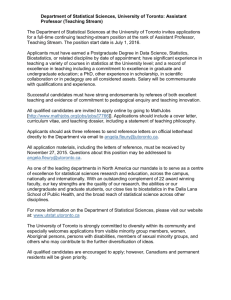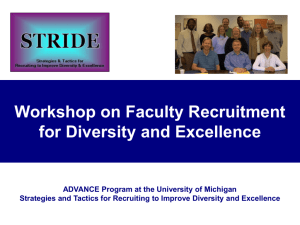Workshop on Faculty Recruitment for Diversity and Excellence
advertisement
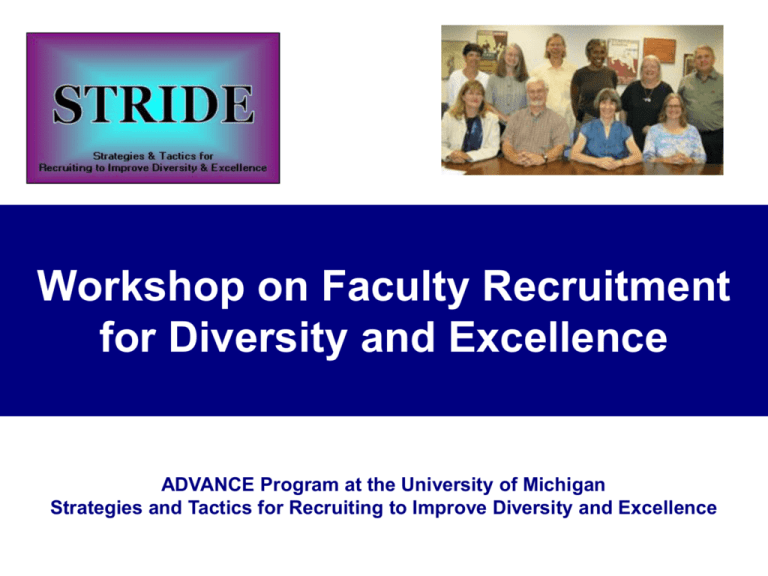
Workshop on Faculty Recruitment for Diversity and Excellence ADVANCE Program at the University of Michigan Strategies and Tactics for Recruiting to Improve Diversity and Excellence STRIDE Committee The STRIDE Committee promotes excellence among faculty in all fields by engaging the campus community in efforts to improve the university environment. STRIDE provides information and advice about practices that will maximize the likelihood that diverse, well-qualified candidates for faculty positions will be identified, and, if selected for offers, recruited, retained, and promoted at the University of Michigan. 2 Overview • Why do we need to recruit a diverse faculty in order to attain excellence? • What are the obstacles to achieving diversity on the faculty? • Exactly how do these obstacles affect all faculty careers (some positively and some negatively)? • What can we do? 3 Why do we need to recruit a diverse faculty in order to attain excellence? • Gives us access to talent currently not represented. • More perspectives are taken into account in devising solutions to problems. • Fewer things are taken for granted; more things are questioned. – Car design was altered by the inclusion of women engineers. •Ely & Thomas (2001). Administrative Quarterly 46 (2), 229-273. •Page, S. (2007). The Difference: How the Power of Diversity Creates Better Groups, Firms, Schools, and Societies: Princeton University Press. •Temm (2008). In L. Schiebinger (Ed.), Gendered Innovation in Science and Engineering (pp. 131-149). 4 An example of why we need to recruit a diverse faculty in order to attain excellence • Professor’s gender has a powerful effect on female students' performance in math and science classes, their likelihood of taking future math and science courses, and their likelihood of graduating with a math, science or engineering degree. – Carrell, Page, & West (2009). Sex and Science: How Professor Gender Perpetuates the Gender Gap. 5 Can we recruit for diversity and excellence? • Proposal 2 “contains an exception that permits any actions—even those that consider race, ethnicity, gender, or national origin—that are mandated by federal law or that are necessary in order for an institution to receive federal funding.” • “Federal law requires the University, as a federal contractor, to take affirmative steps in the employment process in order to adhere to the equal employment opportunity and affirmative action provisions of Executive Order 11246 regarding race, gender, color, religion, and national origin.” • “Employment practices at U-M already complied with Proposal 2; and therefore, did not change. In addition, the University’s nondiscrimination policy remains in effect. The passage of Proposal 2 does not change U-M’s commitment to diversity, nor does it alter the University’s employment practices or the protections and requirements of various federal and state laws.” http://www.diversity.umich.edu/legal/prop2faq.php 6 Nondiscrimination and Affirmative Action • “Recruiting and retaining a diverse faculty is critical to our academic excellence.” • “The University of Michigan is committed to a policy of equal opportunity for all persons and does not discriminate on the basis of race, color, national origin, age, marital status, sex, sexual orientation, gender identity, gender expression, disability, religion, height, weight, or veteran status. The university also is committed to compliance with all applicable laws regarding nondiscrimination and affirmative action.” Regents Bylaw Sec. 14.06. Nondiscrimination and Affirmative Action (revised April 2009) http://www.regents.umich.edu/bylaws/bylaws14.html 7 Why is it difficult to recruit for diversity and excellence? Is the available pool of candidates too homogeneous? • Partly yes, but it does not fully account for outcomes for either race/ethnicity or gender. • The situation differs across fields and departments. • The impact of a reduced pool of candidates is greater for race/ethnicity than for gender. • Under-representation cannot be assessed for sexual orientation or disability. 8 Why is it difficult to recruit for diversity and excellence? It is tempting to believe that discrimination of some groups is a thing of the past, or is only practiced by a small set of uninformed people. Research shows that we all – regardless of the social groups we belong to – perceive and treat people differently based on their social groups (race/ethnicity, gender, sexual orientation, disability, etc.). Valian (1998) Why So Slow? The Advancement of Women. Cambridge: MIT Press, p. 280. 9 Schemas: Non-conscious Hypotheses • Schemas (expectations or stereotypes) influence our judgments of others (regardless of our own group). • All schemas influence group members’ expectations about how they will be judged. 10 11 What is the effect on applicants -- aspiring students and potential faculty? How is it that people committed to diversity made such a web page? It was clearly not done intentionally, meaning that there was an unconscious element. Schemas do… • allow efficient, if sometimes inaccurate, processing of information. • often conflict with consciously held or “explicit” attitudes. • change based on experience/exposure. Nosek, Banaji, & Greenwald (2002). Group Dynamics: Theory, Research and Practice, 6, 101-115. Fiske, Cuddy, Glick, & Xu (2002). Journal of Personality and Social Psychology, 82(6), 878-902. 13 Schemas are… • Widely culturally shared – Both men and women hold them about gender. – Both whites and people of color hold them about race/ethnicity. – People are often not aware of them. • Applied more under circumstances of: – Ambiguity (including lack of information) – Stress from competing tasks – Time pressure – Lack of critical mass Fiske (2002). Current Directions in Psychological Science, 11, 123-128. 14 Schemas Affect Evaluation Numerous studies show that schemas affect evaluation, for example: • Blind auditions • Evaluation of resumes • Evaluation of CVs • Evaluation of job credentials • Evaluation of fellowship applications • Letters of recommendation 15 Blind Auditions: Gender Records from major US symphony orchestras from 1970-1996: • Audition data from 14,000 individuals show the use of a screen increases the probability that a woman will advance from preliminary rounds by 50%. • Roster data from 11 major orchestras show the switch to blind auditions accounts for 30% of the increase in the proportion of women among new hires. Goldin & Rouse (2000) The American Economic Review, 90, 4, 715-741. 16 Evaluation of Identical Resumes: Race • Applicants with African Americansounding names had to send 15 resumes to get a callback, compared to 10 needed by applicants with whitesounding names. • White names yielded as many more callbacks as an additional eight years of experience. Jamal Greg Bertrand & Mullainathan (2004) American Economic Review, 94 (4), 991-1013. 17 Evaluation of Identical CVs: Gender • When evaluating identical application packages, male and female University psychology professors preferred 2:1 to hire “Brian” over “Karen” as an assistant professor. • When evaluating a more experienced record (at the point of promotion to tenure), reservations were expressed four times more often when the name was female. Karen Brian Steinpreis, Anders, & Ritzke (1999) Sex Roles, 41, 509. 18 Evaluation of Identical Resumes: Gender and Sexual Orientation • Nearly identical resumes of law students applying to internships in Canadian law firms. • Gay-labelled male applicants received 62% as many offers as other male applicants. • Gay-labelled female applicants received half as many offers as other female applicants. Thomas Trent Susan Trent Susan Trent Thomas Trent Active in Gay People’s Alliance Active in Gay People’s Alliance Similar and expanded findings: Weichselbaumer (2003) Adam (1981) The Canadian Review of Sociology and Anthropology, 18(2): 216-221. 19 Why do race cues produce different evaluations? Ambiguity in Job Credentials: Race • Identical resumes, but ambiguous fit of credentials to job (rather than ambiguous credentials) –A sample of white evaluators recommended • Black candidate 45% of the time • White candidate 76% of the time • Whites get “benefit of the doubt” in ambiguous situations—bias leading to advantage in this case. Dovidio & Gaertner (2000). Psychological Science, 11, 315-319. 20 Critical Mass Affects the Use of Schemas • When there are many individuals, we differentiate among them and cannot rely on group-based schemas. • In both experimental and field settings, increasing the female share of those being rated increased ratings of female applicants and employees. Valian (1998) Why So Slow? The Advancement of Women. Cambridge: MIT Press, p. 280; Heilman (1980) Organizational Behavior and Human Performance, 26: 386-395; Sackett et al (1991), Journal of Applied Psychology, 76(2): 263-267. 21 Evaluation of Fellowship Applications: Gender “…the success rate of female scientists applying for postdoctoral fellowships at the [Swedish Medical Research Council] during the 1990s has been less than half that of male applicants.” Average rating of applicants as a function of their scientific productivity 3 Score 2.75 2.5 2.25 2 0-19 20-39 40-59 60-99 >99 Total impact males females Women applying for a post- doctoral fellowship had to be 2.5 times more Similar findings: • USA/GAO report on Peer Review in Federal productive to receive the same Agency Grant Selection (1994) reviewer rating as the average male • European Molecular Biology Organization Reports (2001) applicant. • NIH Pioneer Awards: Journal of Women’s Health (2005) & Nature (August 2006) Wenneras & Wold (1997) Nature, 387, 341. 22 Letters of Recommendation for Successful Medical School Faculty Applicants Differences Letters for men: • Longer • More references to: • CV • Publications • Patients • Colleagues Letters for women : • Shorter • More references to personal life • More “doubt raisers” (hedges, faint praise, and irrelevancies) “It’s amazing how much she’s accomplished.” “It appears her health is stable.” “She is close to my wife.” Trix & Psenka (2003) Discourse & Society, Vol 14(2): 191-220. 23 Exactly how do schemas affect the careers of women and underrepresented minorities? Impact of Schemas about Parenthood Assumptions about the implications of motherhood for women’s career commitment have consequences, despite recent data showing that: • Women academics who marry and have families publish as many articles per year as single women. • “…net sex differences in productivity are small to nil once other personal characteristics, structural settings, and facilitating resources are taken into account.” (Xie & Shauman, p.191) Yu Xie and Shauman (2003) Women in science: Career processes and outcomes. Cole and Zuckerman (1987) Scientific American 256 (2), 119-125. 25 Hiring, Assessments, and Salaries: Mothers When evaluating identical applications: • Evaluators rated mothers as less competent and committed to paid work than nonmothers. • Prospective employers called mothers back about half as often as nonmothers. • Mothers were less likely to be recommended for hire, promotion, and management, and were offered lower starting salaries than nonmothers. Mother Active in PTA “Nonmother” Correll, Benard and Paik (2007) American Journal of Sociology, 112 (5), 1297-1338. 26 Hiring, Assessments, and Salaries: Fathers When evaluating identical applications: • Fathers were not disadvantaged in the hiring process. • Fathers were seen as more committed to paid work and offered higher starting salaries than nonfathers. Father Active in PTA “Nonfather” Correll, Benard and Paik (2007) American Journal of Sociology, 112 (5), 1297-1338. 27 Student Evaluation of Teaching Credibility: Sexual Orientation One male instructor provided a guest lecture to 8 sections of a communication course. • In half of lectures, he referred to “my partner Jennifer” and in other half to “my partner Jason.” • The “straight” instructor received 22% more positive comments than the “gay” instructor. • The “straight” instructor received 1/5 as many negative comments as the “gay” instructor. Russ, Simonds, and Hunt (2002) Communication Education, 51:3, 311-324. 28 Racial Diversity Matters in Jury and Search Deliberations Compared with all-white juries, diverse juries deliberating about an African American defendant: – Took longer to discuss the case – Mentioned more facts – Made fewer inaccurate statements – Left fewer inaccurate statements uncorrected – Discussed more race-related issues Jury deliberations may be analogous to faculty search deliberations. Sommers (2006) Journal of Personality and Social Psychology, 90 (4), 597-612. 29 Accumulation of Advantage and Disadvantage… • Any one slight may seem minor, but since small imbalances and disadvantages accrue, they can have major consequences in salary, promotion, and prestige, including advancement to leadership positions. • “Mountains are molehills piled one on top of the other.” (Valian, 1998, p. 4) Merton (1948) Antioch Review, 8, 193-210 and (1968) Science, 159, 56-63. Valian (1998) Why So Slow? The Advancement of Women. Cambridge: MIT Press, p. 280. 30 Impact of Schemas on Leadership • With single sex groups, observers identify the person at the head of the table as the leader. • With mixed sex groups – a male seated at the head of the table is identified as the leader. – a female seated at the head of the table is identified as the leader only half the time (and a male seated somewhere else is identified the other half). Porter & Geis (1981) Gender and nonverbal behavior. 31 Biased Leadership Outcomes Leadership for Asians in Academia 15% of life scientists in the US are Asian/Asian American. Of the 26 council members and 193 members of 11 standing committees in the American Society for Biochemistry and Molecular Biology in 2005, none was Asian/Asian American. Mervis (2005). Science, 310, 606-607. 32 Impact of Schemas on Career: Processes Are Similar Similarities for different groups •Importance and impact of schemas •Lack of critical mass leads to reliance on schemas •Evaluation bias operates •Accumulation of disadvantages operates 33 Impact of Schemas on Career : Processes Are Different Differences between groups • Content of schemas • Likelihood of solo status greater for racial/ethnic minorities than white women; unknown for sexual minorities and people with disabilities • Less full pipeline for racial/ethnic minorities than white women; unknown for sexual minorities and people with disabilities • Added complexity for women of color and others with intersecting identities (e.g., gay African American men, lesbians) 34 If We Do Not Actively Intervene, The Cycle Reproduces Itself Lowered success rate Accumulation of disadvantage Performance is underestimated Schemas Evaluation bias Solo status/Lack of critical mass 35 Schemas Produce a Self-Reinforcing Cycle Schemas, solo status, and lack of critical mass make differential outcomes seem “natural” or expected: – who is in jobs – who applies for jobs – how they are evaluated – who is promoted to leadership positions Schemas, solo status, and lack of critical mass provide unconscious justification for the status quo despite our good intentions and stated values. 36 Policies Reproduce a Self-Reinforcing Cycle • Schemas are embodied in policies. – Tendency to under-value people who do not fit conventional definitions of the discipline. – Concentration of white men at the top; overlooking women and minorities for leadership positions. – Narrow and homogeneous social and professional networks. – Late and reactive implementation of family friendly policies. – Students' awkward, confused, or challenging reactions to faculty who are racial/ethnic minorities, women, or sexual minorities. 37 Break-out Session • Purpose of break-out session – To provide an opportunity to discuss scenarios and brainstorm strategies to minimize evaluation bias or other difficulties • Logistics of break-out session • Process of break-out session – Identify strategies to address scenarios – STRIDE members will take notes – A summary of notes will be posted on the UM ADVANCE Web site (http://sitemaker.umich.edu/advance/home) • After the break-out session, we will present the final section: strategies that address the under-representation of women and minorities in faculty recruitment. 38 What can we do? Strategies for Breaking the Cycle • Increase conscious awareness of bias and how bias leads to overlooking talent – Implicit Association Test: https://implicit.harvard.edu/implicit/ • Develop more explicit criteria (less ambiguity) • Alter departmental policies and practices 40 Recruiting Strategies • • • • • • • Prime the pump Search committee composition Job description Advertisement Active recruiting Interviewing tips Promote awareness of the issues 41 Prime the Pump Particularly in the case of underrepresented minorities, recruitment begins before you have a position. • Cultivate your own students as their careers advance. • Scan the field at professional meetings, in journals, etc. and invite young scholars early and often to visit, give talks, build collaborations. • Invite female and other minority speakers. 42 Search Committee Composition • Include people who are committed to diversity and excellence. • Include women and minorities. – Remember to take account of their added service load in other assignments. – Remember the additional impact of belonging to multiple minority groups. 43 Job Description: Open Searching • Consider implications of the job description: search as broadly as possible. • Work with a single search committee for all positions, to allow opportunities for people with unusual backgrounds to emerge. 44 Active Recruiting • Widen the range of institutions from which you recruit. • Consider candidates, including women and minorities, who may currently be thriving at less well-ranked institutions. They may be there because of: – Early career decisions based on factors other than ranking of institution – Past discrimination by top tier institutions – Candidate’s own internalization of schemas 45 Active Recruiting and Open Searches Can Help Increase Diversity The difference achieved by one UM department 46 UM Faculty Experience with Open Searches Has Been Positive "The open searches led to both a larger number of applicants AND a more diverse applicant pool." "I was not sure if the ‘open search’ is the best way to attract the best candidates to apply for job. I am convinced now it is indeed an excellent strategy to add ‘new blood’ to our department." "The open searches led to a department-wide discussion of all of the applicants. This has the added benefit of everyone on the faculty knowing the candidate and being invested in their success from their first day on campus." 47 Evaluation of Candidates: Promote Awareness of Evaluation Bias • Awareness of evaluation bias is a critical first step. Remember the lessons of: – Blind Auditions – CVs and Resumes – Letters of Recommendation • Spread awareness to the others on the search committee. • Evaluation bias can be counteracted. Bauer and Baltes, 2002, Sex Roles 9/10, 465. 48 Focus on Multiple Specific Criteria during Evaluation • Weigh judgments that reflect examination of all materials and direct contact with the candidate. • Specify evaluations of scholarly productivity, research funding, teaching ability, ability to be a conscientious departmental/university member, fit with the department’s priorities. • Avoid “global” evaluations • ADVANCE has evaluation forms that can be modified to fit your situation. Bauer and Baltes, 2002, Sex Roles 9/10, 465. 49 Candidate Evaluation Tool http://www.umich.edu/%7Eadvproj/CandidateEvaluationTool.doc 50 Interviewing Tips • Bringing in more than one female and/or minority candidate can disproportionately increase the likelihood that a woman and/or minority will be hired. • Treat female and minority faculty applicants as scholars and educators, not as valuable because they are female or minority scholars and educators. Heilman , 1980, Organizational Behavior and Human Performance, 26: 386-95. Hewstone et al., 2006, Group Processes & Intergroup Relations, 9(4): 509–532. Huffcutt & Roth, 1998, Journal of Applied Psychology, 83(2): 179-189. Van Ommeren et al., 2005, Psychological Reports, 96: 349-360. 51 Importance of Meeting Others Who Are Similar • Some candidates will easily meet many people in the department who share their personal characteristics (race/ethnicity, gender, sexual orientation, parent status), but others will not. • Ensure that all candidates will meet a diverse set of people so that they are more likely to meet someone like them. 52 Avoid Questions that Might be Construed as Discriminatory or Offensive • Federal Equal Employment Opportunity (EEO) laws and regulations prohibit discrimination against applicants on the basis of race, color, religion, sex, national origin, age, handicapping condition, marital status, or political affiliation. • Interviews should evaluate qualifications of the applicant that are relevant to a faculty position – questions about matters that are not job relevant (i.e. family status) are not allowed. • Chart of appropriate and inappropriate questions is available at: http://www.hr.umich.edu/empserv/department/empsel/legalchart.html 53 Asking Non-Job-Related Questions Can Be Counter-Productive In a 2007 study of candidates for positions at a UM department, who withdrew from searches or turned down offers, several women mentioned that they had been asked illegal and discriminatory questions about their personal lives. – One candidate reported that she did not answer truthfully (knew the “right” answer and gave it) – One candidate reported that she resented the questions 54 Unique Challenges for Recruiting LGBT Faculty • Federal Equal Employment Opportunity (EEO) laws and regulations do not provide protection for lesbian, gay, bisexual, and transgender/transsexual individuals. • State of Michigan permits single LGBT individuals to petition to adopt but prohibits joint adoption. • No statewide relationship recognition for same-sex couples. • U.S. immigration policy prohibits LGBT individuals from sponsoring their partners for immigration purposes, even when legally married in country of origin. • Hesitation in requesting U-M dual career assistance for partner. 55 Positive Approaches to Role of Personal Life for Faculty Candidates • Many faculty have two-career households. • Female faculty are more likely to have a partner who is employed fulltime. – UM climate study (2006) • At UM, “family” is defined broadly, but candidates may not expect that. • Family friendly policies provide resources to help both male and female faculty manage households. • Process should begin early: – Distribute family friendly policy information to all candidates before or during first visit. – Expeditiously address family issues raised by candidate. 56 Dual Career Issues Should Not be Discussed by the Search Committee • • Identify someone with whom the candidate can have a confidential conversation in which they could ask questions they don’t want to ask the search committee. The Provost has a Dual Career Program. – Provides services to domestic partners of faculty recruits regardless of marital status or sexual orientation. – Department Chairs request assistance through their Deans • Ensure all candidates know about dual career support mechanisms available at the University of Michigan. – http://www.provost.umich.edu/programs/dual_career/index.html – http://www.umich.edu/~hraa/empserv/dual/ – http://www.michiganherc.org • Support for dual careers enhances both recruitment and retention of men and women. 57 Top Mistakes in Recruitment • • • • • • Committee does not have a diverse pool. The committee discussed information about the candidate that is inappropriate. Asking counter-productive questions. Telling a woman or underrepresented minority candidate that "we want you because we need diversity." The candidate does not meet others like themselves during the visit. Committee or faculty make summary judgments about candidates without using specific criteria. 58 When We are Successful: Factors from Recruitment/Hiring Interview Study Factors Reported to Influence Decisions to Accept Positions at UM • • • • Reputation or ranking of department or College Quality of faculty and graduate students Research and career opportunities Start-up package and salary • • • • Resources/facilities Dual career options Collegial/positive atmosphere Geographic location ADVANCE Program at the University of Michigan (2009). Recruitment/Hiring Interview Study: Faculty Who Accepted Offers. 59 Recruitment is just the beginning! • Provide help with networking and getting established at U-M. • Show an interest in other aspects of adjustment to life in Ann Arbor. • The ADVANCE Program promotes excellence among faculty in all fields in four general areas: – – – – Recruitment Retention Climate Leadership http://sitemaker.umich.edu/advance/home Phone: (734) 647-9359 E-mail: advanceprogram@umich.edu 60
